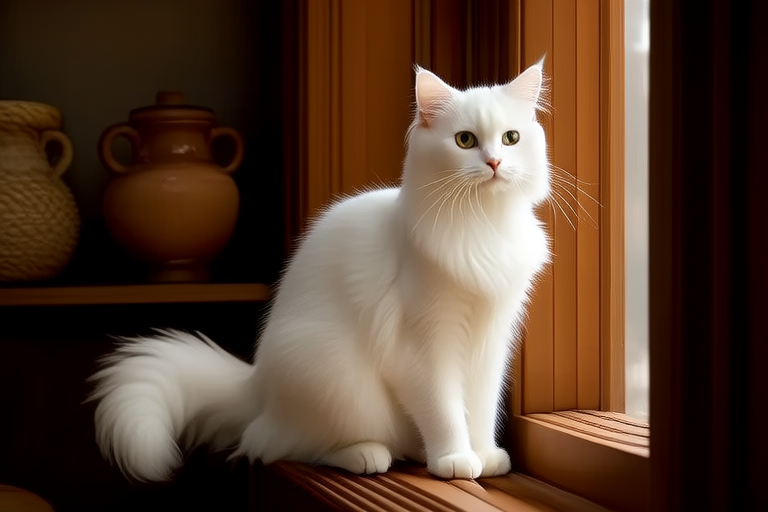Turkish Angora Cats: Legends in Fur and Feather
For centuries, the Turkish Angora has been captivating hearts and minds with its elegance, grace, and unique charm. Originating from the Ankara region of central Turkey, these felines have woven themselves into the fabric of both history and culture. This article delves into the rich heritage, distinctive features, and cultural importance of the Turkish Angora, offering a comprehensive guide for those who admire and aspire to own one of these legendary creatures.
The Origins of Turkish Angora Cats
The Turkish Angora’s history is as storied as it is ancient. These cats are believed to have originated around 6,000 years ago in the Anatolian plateau of what is now modern-day Turkey. Their name, Turkish Angora, derives from the capital city of Ankara, formerly known as Angora. The breed has been cherished by the Turkish people for centuries and was once considered a symbol of wealth and nobility.
Historical records suggest that the Turkish Angora was a favorite among the Ottoman sultans and other noble families. They were often presented as gifts to foreign dignitaries, further enhancing their reputation as a breed of exceptional beauty and prestige. The cats’ striking white coats and large, expressive eyes made them stand out even in the grand palaces of the Ottoman Empire.
Distinguishing Physical Traits
The Turkish Angora is renowned for its sleek, silky coat, which can range from pure white to various colors and patterns. Their coats are typically short and fine, requiring minimal grooming. One of the most striking features of the Turkish Angora is its eyes, which come in a variety of colors, including blue, green, gold, and even heterochromia (two different colored eyes).
Besides their stunning appearance, Turkish Angoras are also known for their agility and athleticism. They are graceful, acrobatic cats, capable of leaping to great heights and landing with precision. Their slender bodies, long legs, and large ears contribute to their agility, making them excellent hunters and playful companions.
Temperament and Personality
Turkish Angoras are intelligent, curious, and highly social animals. They thrive on human interaction and are often found following their owners around the house, seeking attention and affection. Despite their independent nature, they enjoy being part of a family and can form strong bonds with their human companions.
These cats are known for their playful and active demeanor, particularly during their younger years. They are highly adaptable and can adjust to various living environments, whether it be a bustling household or a quiet apartment. Their friendly and gentle disposition makes them ideal pets for families with children or other pets.
Cultural Significance
The Turkish Angora has played a significant role in Turkish folklore and mythology. In many tales, the Turkish Angora is depicted as a guardian spirit, watching over homes and protecting their inhabitants from harm. One popular myth tells the story of a Turkish Angora cat that saved a village from a marauding army by leading the soldiers into a trap.
In addition to their role in folklore, Turkish Angoras have been featured in Turkish art and literature. They have inspired countless paintings, poems, and stories, cementing their place as cultural icons. The Turkish government has even recognized the breed’s importance by establishing a breeding program at the Ankara Zoo, ensuring the preservation of this beloved national treasure.
Hypoallergenic Qualities
One of the most appealing aspects of the Turkish Angora is its hypoallergenic qualities. While no cat is entirely hypoallergenic, Turkish Angoras produce less of the protein Fel d 1, which is responsible for causing allergic reactions in some individuals. This makes them a more suitable choice for allergy sufferers compared to other breeds.
However, it’s important to note that individual sensitivities may vary, and those with severe allergies should consult with a healthcare professional before considering a Turkish Angora as a pet. Regular grooming and maintaining a clean living environment can also help minimize allergens.
Famous Turkish Angoras
Several Turkish Angoras have achieved fame throughout history, both within Turkey and abroad. One such cat is Muezza, a Turkish Angora said to have been a favorite of Prophet Muhammad. According to legend, when a fly landed on his ear, Muhammad asked Muezza to remove it. Instead of waking him, the cat reportedly removed the fly with its paw, earning the Prophet’s praise and a lifetime of luxury.
Another notable Turkish Angora is Selim III, a cat that belonged to the Ottoman Sultan Selim III. Known for its intelligence and loyalty, Selim III became a symbol of the sultan’s benevolence and wisdom. The cat’s story has been passed down through generations, inspiring admiration and respect for the Turkish Angora breed.
Historical Events and Figures
The Turkish Angora has been involved in several historical events and has been associated with influential figures. During World War I, Turkish Angoras were used as mascots by Turkish soldiers, boosting morale and providing comfort during difficult times. The cats’ presence on the battlefield helped create a lasting bond between humans and animals, highlighting the importance of companionship in times of conflict.
In more recent history, Turkish Angoras have been featured in international cat shows and competitions, showcasing their beauty and grace on a global stage. Their participation in these events has helped raise awareness of the breed and its unique qualities, contributing to its growing popularity among cat enthusiasts worldwide.
Conclusion
The Turkish Angora is much more than just a cat; it is a living piece of history and culture. With its elegant appearance, agile nature, and hypoallergenic qualities, the Turkish Angora continues to captivate and inspire. Whether you’re a seasoned cat enthusiast or considering adopting your first feline friend, the Turkish Angora offers a unique and rewarding companionship experience. As you explore the world of Turkish Angoras, remember the rich history and cultural significance that have shaped this remarkable breed, and appreciate the legends in fur and feather that have enchanted generations.
